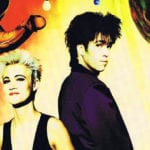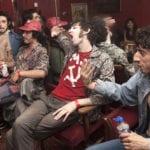 Technology
Technology  Technology
Technology  Humans
Humans 10 Everyday Human Behaviors That Are Actually Survival Instincts
 Animals
Animals 10 Animals That Humiliated and Harmed Historical Leaders
 History
History 10 Most Influential Protests in Modern History
 Creepy
Creepy 10 More Representations of Death from Myth, Legend, and Folktale
 Technology
Technology 10 Scientific Breakthroughs of 2025 That’ll Change Everything
 Our World
Our World 10 Ways Icelandic Culture Makes Other Countries Look Boring
 Misconceptions
Misconceptions 10 Common Misconceptions About the Victorian Era
 Mysteries
Mysteries 10 Strange Unexplained Mysteries of 2025
 Miscellaneous
Miscellaneous 10 of History’s Most Bell-Ringing Finishing Moves
 Technology
Technology Top 10 Everyday Tech Buzzwords That Hide a Darker Past
 Humans
Humans 10 Everyday Human Behaviors That Are Actually Survival Instincts
 Animals
Animals 10 Animals That Humiliated and Harmed Historical Leaders
Who's Behind Listverse?

Jamie Frater
Head Editor
Jamie founded Listverse due to an insatiable desire to share fascinating, obscure, and bizarre facts. He has been a guest speaker on numerous national radio and television stations and is a five time published author.
More About Us History
History 10 Most Influential Protests in Modern History
 Creepy
Creepy 10 More Representations of Death from Myth, Legend, and Folktale
 Technology
Technology 10 Scientific Breakthroughs of 2025 That’ll Change Everything
 Our World
Our World 10 Ways Icelandic Culture Makes Other Countries Look Boring
 Misconceptions
Misconceptions 10 Common Misconceptions About the Victorian Era
 Mysteries
Mysteries 10 Strange Unexplained Mysteries of 2025
 Miscellaneous
Miscellaneous 10 of History’s Most Bell-Ringing Finishing Moves
Top 10 Rock Bands that Succumbed to Disco Fever
In 1978, disco was thriving and cocky. In that same year, it had a hit contract out on it. The proverbial assassins? Rock traditionalists who weren’t comfortable with the sexual ambiguousness and song-oriented nature of the genre. After all, men in leisure suits and platform shoes, and girls with big hair and shiny dresses didn’t actually need a live band to provide them the goods to get footloose; they could do it all the same with a tireless DJ, and a spinning record. Add the fact that girls need not copulate when they have a steadfast dance partner, and the result was unmoderated “Disco Sucks” rallies (with behavior not unlike some internet comment sections) and bonfires perfect for burning both witches and Village People records, alike. However, as much as these Skynard-and-Zeppelin-worshipping disco-bashers wanted to see the demise of a genre, such was futile. Disco merely went into hiding, into the closet if you will. Meanwhile, its influence is ubiquitous and rock bands to this day can’t deny their lineage. Here are the top ten rock bands that couldn’t escape the effects of disco’s true power (some might prove quite equivocal to your hard-as-a-rock expectations):
Even a member of the band that single-handedly shaped the face of music found himself trapped in the arms of a genre too irresistible for even a rock pioneer. The disco-inspired “Goodnight Tonight” was recorded in 1978, when the genre was high-flying, and mixes Latin dance elements with a funky bassline, that also sounds like it was more derivative of disco’s ancestors, rather than its imitators. Which makes sense: Paul McCartney’s songwriting has always seemed to be the result of careful studying and an appreciation for classical values, hard work and diligence, opted for in an environment of rampant plagiarism.
Yes, Kiss. It really shouldn’t be so much of a shock that these space-clown-looking glam-rockers would be superficial enough to indulge in a genre that invited nothing but (transient) commercial success. Is selling out really a new concept for a band known for capitalizing on every possible merchandising gimmick and “band-to-brand” exploitation, from action figures to lunch boxes to promotional films starring the band members as characters? The song “I Was Made for Lovin’ You” combines a disco-ish drumbeat and choral flair (falsetto!) with the unmistakable power chord surge Kiss never operates without. The star-eyed Paul Stanley was apparently quoted to admit he made the song only to prove how easy it is to make a disco hit. The result sounds as catchy as do a couple of cats who got into the neighbors’ trashcans.
If you think this band successfully avoided the alluring jaws of disco, think again. You hear echoes of a distant dancefloor in every chugging, itchy bass groove (such as in “Young Lust”), or the steady, slightly delayed chord chops by a ninja-like guitar in “Another Brick in the Wall” off Pink Floyd’s conceptual Wall album. And “Run Like Hell,” more than anything, makes you want to dance like hell. Released in 1979, the shadow of disco hadn’t completely dissipated, this “wall” showing both the presence and absence of light of the glowing juggernaut overhead. How ‘bout that, album-oriented rock and disco coexisting in perfect harmony.
One of the most theatrical rock bands of all time made a disco album, 1982’s Hot Space, following a persisting danceability with dance-beat-filled tracks like “Another One Bites the Dust” from 1980’s The Game; “Back Chat” contains a very infectious, and relatively toned-down, disco-ball-gleaming groove while “Staying Power” is a hyper, high-strung bit of motion sickness-inducing madness. Freddy Mercury was every bit the man to lead a disco revolution, even if critical success eluded this album. Nonetheless, a great rock band finds its way to unyielding disco submission and does so with great, sincere-sounding enthusiasm.
From Faces to Vegas, Rod Stewart has had quite the career of shape-shifting over-indulgence. In Faces, he was the lead “face”, alongside Ron Wood and members of the Jeff Beck group, belting it out over some wailing blues-rock. The blues stayed true to Stewart, even in his solo career, singing heart-broken blues ballads whenever the chance presented itself. But, they never held him back from sipping from other people’s drinks. Take 1981’s Tonight I’m Yours, or 1984’s Camouflage, which contain some traces of the kind of synth-heavy sonics prominent all over the decade; nonetheless, you don’t have a compromise of well thought out songwriting: decided chord arrangements aren’t replaced, so much as complimented by synthesized production-work. And the blues remain. As well as soul-steeped choruses. But for the ultimate disco experience, you’ve got to check out “Do Ya Think I’m Sexy?” which was cranked out right at disco’s high point (1978), an obvious indulgence in what was ever so sweet and abundant at the time. And Stewart, if he’s one thing, is certainly a hedonist.
As an avant-gardist, experimentation is nothing out of the ordinary, which includes musical. Bowie has been an ever elusive face of many movements which he helped to create, from glam to dance to abstract rock, always maintaining a relevant, yet timeless sound. 1983’s Let’s Dance is a perfect example of such. Even in the wake of disco, this album fed off everything that made disco so great, the swelling hooks and propulsive, infectious grooves, and Bowie held no shame in the unabashed expression, celebration even, as he named the album after what he hoped to inspire: an amply scuffed-up dance floor. The title track features a fantastic guitar echo, and a bass line that won’t quit, before a doo-wop harmony sets everything up to start all over again. Underrated by dance rock-shunners, this album is just as consistent as anything else in Bowie’s catalogue, and has been highly influential for future generations of open-minded rockers.
The Clash pissed off a lot of early punks. Mostly because they didn’t follow suit and observe the very simplistic prototypes of the punk genre. However, they defied genre categorization with every chance. Sure their debut was a milestone for what could be done within punk rock, maintaining that garage-y, exclusively guitar-and-riff-based, tight sound, and London Calling carried on the torch, with some ska and classic rock-and-roll-inspired inclusions. But Sandinista was largely a dance album, if not a melting pot of multifarious sounds. “The Magnificent Seven” and “The Call Up” used stabbing guitar licks and a propulsive bassline to ignite a disco fury no resistant punk uprising could hope to overcome. They had previously foreshadowed their affections for disco with songs like “Rock the Kasbah,” showing that punks were capable of more than just contemptuous and subversive rage.
This CBGB-staple was the ultimate genre-dabbler, hardly ever settling on any one in particular; they’ve tapped into some of the first incarnations of rap (“Rapture”), ska (“Die Young and Stay Pretty”), and, yes, disco. But Blondie never made a “disco album” so much as incorporated some awesome dance rock tracks in several of their largely eclectic albums. There’s “Heart of Glass” which appears on the same album (Parallel Lines) as the punkish “One Way or Another” and a cover of the early rock and roll classic “I’m Gonna Love You Too” (also covered by the likes of Buddy Holly). That wasn’t their only disco-sploration: there’s “Atomic” from Eat to the Beat, which gives way to a sound Franz Ferdinand would come to emulate in the 00’s, and “Rapture” from Autoamerican, in which Debbie Harry, herself, raps to a sharp disco kick in between lovely vocal hooks. Autoamerican, for one, was an appropriate choice of album names, from a band always leaning towards the future and every sonic progression.
Yes, even the manliest band of all time couldn’t eluded disco’s gravitational pull. The Rolling Stones are so often labeled as being the Beatles’ evil counterparts, but putting aside crunching blues riffs and effectively crude vocals, these boys have a definite glittery side. Just look at Mick Jagger’s hip gyrations that swivel to this day, like a young John Travolta, and well out of the late seventies. And there’s the album Some Girls, an undeniable disco album that even die hard Stoners don’t take seriously. It was made at the height of Disco’s mainstream dominion, and influenced by frequent disco club-dwelling. The song “Miss You”, for instance, originally comes in at over eight minutes, a perfectly self-indulgent length for a single made for the club circuit.
The Brothers Gibb are the most renowned for their masculine disco-friendliness, but that wasn’t always the case; prior, they were mere Beatles emulators, with Barry unable to hide the influence is his harmonized voice or candid confessions. There was a lot of sentimental ballad-work going on, what with the towering ode to the state of “Massachusetts,” aptly named so. After all they’ve been making music since the sixties. Then in the seventies, it seemed they needed to branch out and experiment, trying out some white guy R&B and funk, and Main Course seemed to be the dish upon which all collided: it was their seminal Disco album, outside of their healthy contribution to the Saturday Night Fever soundtrack (6 songs, one of which also appears on Main Course). These guys knew how to take a genre and own it, for what other band comes to mind when you think of disco?








